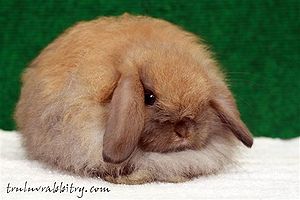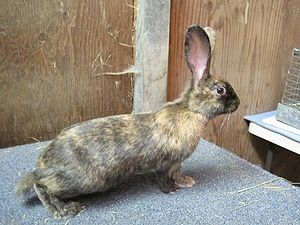Breeds FAQ
What is the difference between a rollback and flyback coat?
When you rub a rabbit the wrong way, the fur of a flyback coat should "fly" immediately back in place. On the other hand, the fur of a rollback coat usually stands up more and should "roll" more slowly back in place. The rollback coats have a denser and thicker undercoat while a flyback coat lies closer to the body and has more thicker guardhairs.[1] Rollback fur is longer than flyback fur.[2]
What are the differences between a Polish and Netherland Dwarf rabbit?
The Netherland Dwarf is a breed that is descended from the Polish rabbit. The Netherland Dwarf is a true dwarf with a single dwarf gene while the Polish does not carry any dwarf genes.
While the two breeds are often confused, there are a couple of distinctive differences between the two breeds.[3]
- The Polish can be up to 3.5 lbs for show, while the Netherland Dwarf can only be up to 2.5 lbs. However, either breed can weigh from 1.5 - 4.5 lbs.
- The Polish have a flyback coat while the Netherland Dwarf has a rollback coat.
- The Polish is built like most compact breeds with the shoulders narrower than the hips. The head should not sit high on the shoulders. The Netherland Dwarf is built to be the same width at the shoulders and hips and are shown sitting upright with the head held high.
- The ears of a well-bred Polish should touch from base to tip. The Netherland Dwarf has erect ears, but they do not have to touch from base to tip.
- The head of a Polish should be wide between the eyes and taper to a slightly narrower muzzle while still be short and have round cheeks. The face of a Netherland Dwarf is round and flattened.[4]
Why does my purebred Holland Lop have long fur?
Some purebred Holland Lops may have long woolly fur more like an American Fuzzy Lop, technically a different breed. This is because Holland Lops can carry the l locus wool/Angora gene. A Holland lop with two recessive wool genes (ll) is a fuzzy Holland. Fuzzy Hollands tend to have longer wispier fur than American Fuzzy Lops.[5]

Why does my purebred Rhinelander rabbit have harlequin-colored fur?
The color of a purebred Rhinelander rabbit is a broken tricolor, genotype (aa B_ C_ __ ejej Enen). A harlequin coat color is genotype ejej with no broken gene (enen). As a result, if a Rhinelander rabbit fails to inherit a broken gene from its parents, it will have a harlequin coat instead.[6] These rabbits are called Rhinelander sports.

Why does my purebred Hotot rabbit look like a Dutch or broken colored rabbit?
The Hotot markings are made from a combination of the Dutch (Dudu) and English Spotting (EnEn) genes. These mismarked rabbits can still produce properly marked kits. The full genotype of a show Hotot rabbit is aa B_ C_ D_ E_ EnEn Dudu.[7]
Further reading
- Pamela Nock. The Dwarf Hotot [PDF]
What is the dwarf gene?
The dwarf gene is a simple dominant gene that creates that cute flattened round face, a compact body, and short ears as seen in purebred Netherland Dwarfs and Holland Lops. Other breeds that carry the dwarf gene include American Fuzzy Lop, Dwarf Hotot, Jersey Wooly, Lionhead, Mini Rex and Mini Satin rabbits.
The dwarf gene is a lethal gene -- if a baby rabbit has two dwarf genes from their parents, they are called peanuts and always pass away within a few weeks. Please note that peanuts are different than runts that are smaller than usual but are still viable.
Dwarf breed rabbits can also end up with no dwarf genes and are called false dwarfs. Their ears will be a bit longer than usual, and the body and feet will be a bit larger.
Some additional resources:
- Raising-Rabbits.com. Dwarf Rabbits: Managing With the Dwarf Gene
- Wintertime Rabbitry. (2016). Cheat Sheet: Understanding the Dwarfism Gene in Rabbits (Graphic)
How long does it take a lop rabbit's ears to fully drop?
Most lop bunnies will have their ears drop anywhere from 6 weeks to 6 months old, but some rabbits may maintain ear control until their head fully develops at around 2-3 years old. Some purebred lop rabbits may also never have their ears fully lop due to the shape of their head and ears.
If your radar-eared rabbit has suddenly lopped an ear, it could either be a sign that they have some lop heritage finally showing, or it could possibly be an ear injury or infection. The latter will likely include excessive head shaking and ear scratching and would warrant a rabbit-experienced veterinary hands-on exam for a diagnosis and appropriate treatment.
Some additional resources:
- Cedar Point Rabbitry. (2018). Q & A: Get to Know Your Crowns!
How do the REW, BEW, and pointed white genes work together in a rabbit?
The 'vv' of a BEW (blue-eyed white) removes all body color, leaving the blue eye. However, the REW (cc, ruby-eyed white) and PW (ch_, pointed white) genes will further remove all color from the eye, and the rabbit will look like a REW but genetically also a BEW. Pointed white (ch) genes are dominant over REW (c) genes.
- REW + BEW = ccvv, looks like a REW
- PW + BEW = ch_vv, looks like a REW
References
- ↑ rabbitsontheweb.com. (n.d.). Roll-back or Fly-back? Retrieved 12 Jan 2016 from http://www.rabbitsontheweb.com/forum/viewtopic.php?f=1&t=5111
- ↑ Mosaic's Rabbitry. (n.d.). Rabbits by Fur Type. Retrieved 12 Jan 2016 from http://mosaicrabbitry.weebly.com/rabbits-by-fur-type.html
- ↑ Dorothy Pohorelow. (2001). Polish vs Netherland Dwarfs. Retrieved 12 Jan 2016 from http://wykvlvr.tripod.com/polish.html
- ↑ USA Rabbit Breeders List. (n.d.). Polish Rabbits. Retrieved 12 Jan 2016 from http://rabbitbreeders.us/polish-rabbits
- ↑ Laurie Stroupe. (n.d.). Fuzzy Holland Lop Genetics - The Wool or Length Gene L. Retrieved 12 Jan 2016 from http://www.thenaturetrail.com/rabbit-genetics/fuzzy-holland-lop-wool/
- ↑ Raising-Rabbits.com. (n.d.). E Locus Rabbit Colors. Retrieved 12 Jan 2016 from http://www.raising-rabbits.com/e-locus-rabbit-colors.html
- ↑ DebMark Rabbit Education Resource. (1998). The Hotot Rabbit. Retrieved 27 Jun 2019 from http://www.debmark.com/rabbits/breeds/hotot.htm

